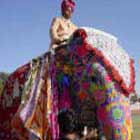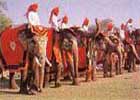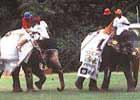As the name suggests, it is a festival where the elephants are the
centre of attraction. This festival is celebrated on the day of
Holi, the Indian festival of colours. They stride majestically
parading their decorated trunks and tusks.
Every year on the day after Holi, the old stadium at Jaipur, the
Chaugan (originally planned for elephants), forms the venue for a
spectacular jamboree and is brought alive with elephants, dancers,
musicians, and onlookers from the entire globe. The festival begins
with an impressive procession of the majestic animals lovingly
painted and tastefully attired with glittering ornaments and
embroidered velvets. Then follows the camels and horses, followed
by lively folk dancers at their entertaining best.
Most of the participants are female elephants. The mahouts
(elephant keepers) take great care to decorate the elephants,
painting their trunks, foreheads, and feet with floral motifs and
adorning them from tusk to tail with interesting trinkets. The game
of polo forms one of the highlights of the festival. Dressed in
saffron and red turbans, the teams try to score goals with long
sticks and a plastic football. The most interesting event of the
day is a tug of war between the elephants and men are some of
the attractions.
Finally, the tourists are invited to mount the elephants and play
Holi. Participants dance with great vigor-the excitement rising to
a crescendo.
Rajasthan Tourism revived the tradition of the Rajput Maharaja’s
by including the Elephant Festival in the cultural calendar. The
present-day pageant, originated only a decade ago, was devised
especially with the tourist in mind. The inclusion of the game of
polo is more recent, being inspired by a cartoon in Punch magazine
that showed the Indian polo team atop an elephant after it won all
the international tournaments.
A program of Dhaph and Gair dance to demonstrate the spirit of Holi
and a dazzling display of fireworks complete the day leaving
unforgettable memories.
Festivals and Fairs |
   |



